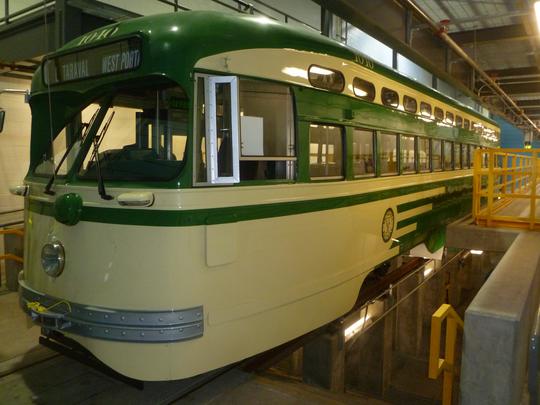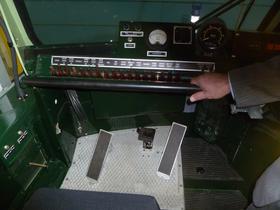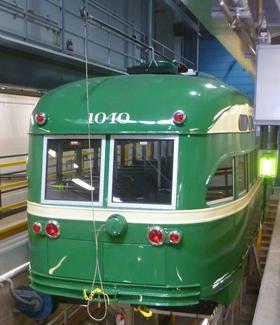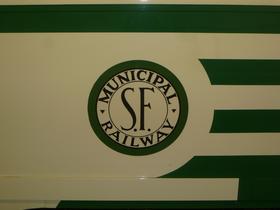
Restored Muni PCC No. 1040 at Muni Metro East, December 15, 2011. (Yes, it can run the outer end of the L-Taraval line, and others, too.) Click photos to enlarge.
During its “first life” at Muni, PCC No. 1040 was always the kid, the youngest in the fleet. Indeed, it is historic for being the last of nearly 5,000 streetcars of this type built in the U.S., coming off the assembly line at St. Louis Car Company in 1952.
Now, for a little while at least, it’s Muni’s “newest” historic streetcar as well. It’s back in San Francisco following a complete rebuilding at Brookville Equipment Company in Pennsylvania. What a difference from the way it looked when it left San Francisco almost exactly two years ago.
Market Street Railway has always been a strong advocate of restoring this particular streetcar for the F-line fleet because of that “last-PCC-built” distinction. For the same reason, we advocated special touches for this car to keep its historic fabric as intact as possible. These include retaining a headlight casing as close to the original “Golden Glow” design as possible, rather than substituting a smaller sealed beam automotive type headlight as was done on almost all Muni’s PCCs (but not this one) during the 1960s and 1970s. And, of course, we asked that it be restored in its as-delivered green and cream “Wings” livery.
An inspection of No. 1040 at Muni Metro East, where it was unloaded, shows a restoration pretty faithful to the original. Externally, the headlight; the original style dash lights; and the front trolley catcher, which matches the size and location of the original, are all nice touches. On the rear, openable aluminum windows are back, replacing the sealed glass that came later. Originally, the operator could open them to reach the trolley rope if necessary when backing the car. Now, they double as emergency exits for the car.
The only exterior detail that seems to be missing is the “Enter Front” decal. Though this “Baby Ten” class of 25 streetcars were originally used both a motorman and conductor, with passengers boarding at the center doors, we and Muni agreed to interpret the restoration on No. 1040 to the period starting in 1954, when it started running with only one operator, hence the decal to direct riders to the front door. Then again, with Muni actively considering all-door Proof of Payment operation for the F-line (with our support), putting that decal back on No. 1040 may be premature.
Small details aside, though, the exterior look of No. 1040 is both beautiful and evocative of the decades when Muni’s PCCs dominated Market Street on the J, K, L, M, and N lines.

The operator’s panel is original, though some switches have been reassigned (such as the microphone — originally, operators just shouted!). The speedometer is new as are a few other electronic components. Click photo to enlarge.
The interior of No. 1040 shows similar attention to detail. Full compliance with the Americans with Disabilities Act required the flip-up seats and cabinet for the boarding ramp that all of the F-line PCCs have. But the original conductor’s station, a side-facing seat opposite the center doors, where the conductor collected fares, has been restored. The original operator’s panel is still there, too, though now augmented by modern electronics for switch control, GPS, and communications. Oh, and a speedometer, which – amazingly – original PCCs never had.
With several of the 1070-class PCCs ahead of it in the testing queue, it may be a few weeks before we see No. 1040 on the street, even for testing. Like the 1070 class cars now being tested on the L-Taraval line, No. 1040 has new door controls that have taken a lot of adjustment, so it’s not clear how long its testing period could last. We’ll let you know when it begins testing, and certainly when it goes into revenue service.
After No. 1040 has successfully reentered the fleet, the plan is to consider repainting No. 1050, not originally a Muni car, from its current identical “Wings” paint scheme to one not yet represented in the PCC fleet. For cost reasons that would happen when the car needs a complete repainting anyway.


Wow Awesome
Thanks for including the link to the “before” article. What a difference two years make (when they’re spent in the “rehab” shop). It’s definitely “ready for its closeup” on Dec 28 of next year. Now we can look forward to seeing a similar “before and after” for 1009 and its mates.
1040 looks great! I had no idea the original rear windows looked so different from the sealed glass of later years so that’s a surprise there.
Can’t wait to see 1040 with fellow “wings”-car 1050 on the streets when it enters service. Speaking of 1050, hopefully us blog readers can have a say in what scheme it’ll wear next. I have my own ideas on that, but I’ll hold it until decision time comes.
The car looks fantastic! Hopefully, our group will be able to charter next summer for our annual August charter.
As for 1050, I vote for Pittsburgh Railways red & cream, since 1050 ran for 44 years in Pennsylvania (as Philly 2119), and Pittsburg Railways had the second largest PCC fleet in the US.
Harry Donahue
Friends of Philadelphia Trolleys
Wow!
1040 looks great!
Can’t wait to see the torpedo’s back in restored condition.
Looking forward to riding it again.
Wow, She looks wonderful No!! That’s not it. BEAUTIFUL. Outstanding work. Compared to how she looked when she left MUNI. To being at Brookeville dis -assembled. Words cannot explain. I can’t wait to see 1008 and 1009 return. 1009 being the worst of them all. High 5 and coodo’s to BECo.
Don’t rush this beautiful girl into service. I hope Muni takes the extra care trying to get this beautiful lady into service.
What a beautiful trolley!
Those folks in the paint shop do great work.
The paint shop folks DO do a beautiful job (they’re currently repainting No. 1052) but this work was done by the contractor, Brookville Equipment of Pennsylvania, to specs drawn up by us, specifically, our great volunteer Bill Wong, who is meticulous in sweating the details.
Congratulations on getting Muni PCC car #1040 repaired! Corgi, the British toy maker, made a very detailed diecast model of this streetcar in 1997, so I have a special interest in it. The Photos on this website definitely look impressive and looks very similar to the Green and Cream Wing color scheme on my Corgi model.
It’s been more than repainted. It has been completely rebuilt. Almost all new body panels, propulsion based on the original, windows, wiring, etc.
Excellent repainting and restoration on #1040…WOW!!! I am not surprised that it should be able to get that special attention and appreciation, particularly given the light that I believe that car could have a key role in any special celebration in connection with the upcoming 100th anniversary of MUNI.
By the way, #1040 was the one car I looked forward and wanted to ride during the summer of 1985 when I visited San Francisco from New York City. She rode great then, and it is indeed one of my favorite PCC’s ever built.
Great to see the last PCC car restored. I do remember riding this car when I was growing up. I also rode on the PCC in Toronto, Canada back in the 1980’s.